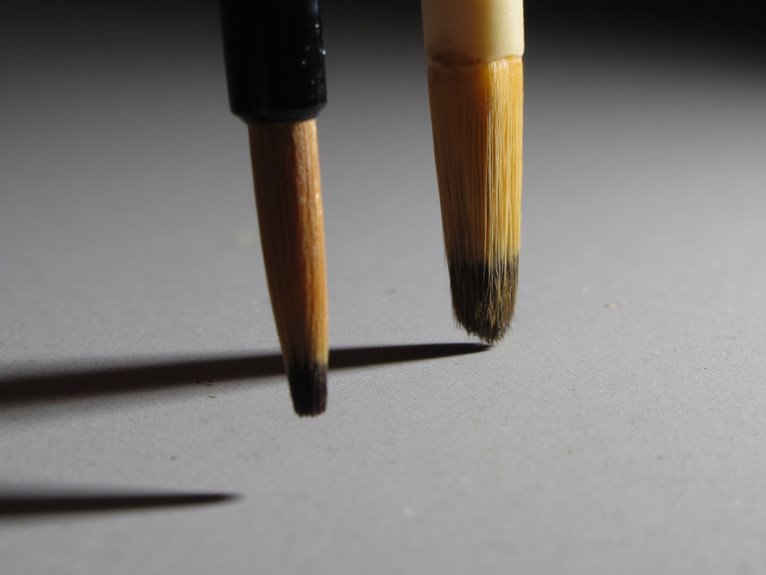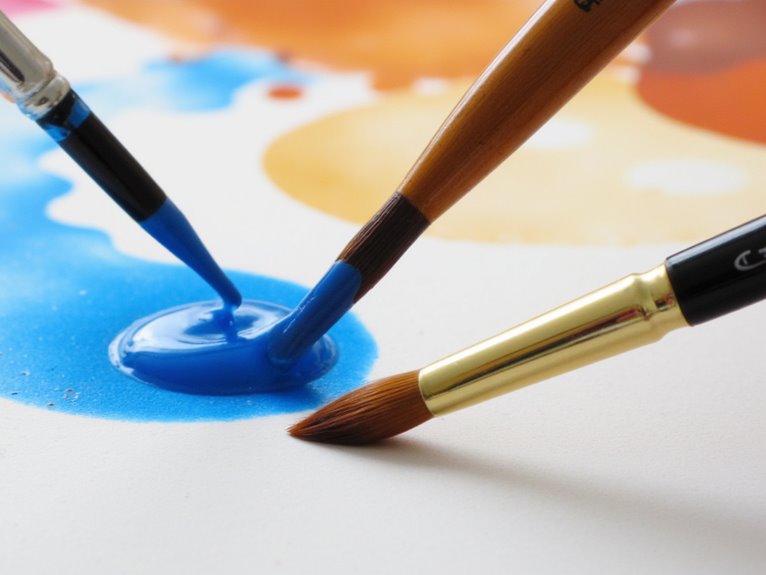We are supported by our audience. When you purchase through links on our site, we may earn an affiliate commission, at no extra cost for you. Learn more. Last update on 30th June 2025 / Images from Amazon Product Advertising API.
You’ll find natural brushes excel at paint retention, holding 40% more paint than synthetics, making them ideal for blending techniques and longer painting sessions. However, they cost $15-40 and require careful maintenance with gentle cleaners. Synthetic brushes offer superior durability, lasting through harsh solvents while maintaining precise tips for detail work, though they hold less paint and need frequent reloading. Budget-conscious painters favor synthetics at $2-8, while professionals often choose natural brushes despite ethical concerns about animal sourcing. Understanding these trade-offs will help determine which brush type suits your specific miniature painting needs.
Notable Insights
- Natural brushes hold 40% more paint and excel at blending, while synthetic brushes offer superior control for detail work.
- Natural brushes cost $15-40 initially but last hundreds of uses; synthetic brushes cost $2-8 but need replacement after 20-70 uses.
- Synthetic brushes resist harsh cleaning agents and solvents better, while natural brushes require gentle care and conditioning oils.
- Natural brushes raise ethical concerns from animal sourcing, while synthetic brushes contribute to plastic pollution and carbon footprints.
- Natural brushes provide better paint retention requiring fewer reloads, but synthetic brushes maintain functional tips longer under heavy use.
Understanding Brush Material Composition and Construction
When selecting brushes for miniature painting, understanding the fundamental differences between natural and synthetic bristle materials directly impacts your painting results and long-term costs.
Natural brush types feature animal hair from hogs, squirrels, badgers, or sables. These materials provide exceptional bristle softness and smooth paint release due to their porous structure. Synthetic alternatives use engineered nylon, polyester, or specialty fiber blends designed to replicate natural performance characteristics.
Brush construction involves three critical components: bristles, ferrule, and handle. The ferrule’s metal band determines structural integrity—seamless versions indicate superior build quality over crimped alternatives. Chrome-plated ferrules offer enhanced rust resistance compared to standard metal options.
Handle materials include wood or plastic, affecting weight distribution and control precision. Natural bristles pair with traditional ferrules, while synthetic fibers require specialized ferrule designs preventing bristle loss during extended use sessions. Natural brushes command higher prices due to the costly manufacturing processes involved in sourcing and preparing animal hair materials. Synthetic brushes demonstrate superior resistance to damage from cleaning solvents and harsh chemical agents.
Bristle Performance Characteristics for Detail Work

Beyond material composition and structural design, bristle performance directly determines your success with miniature detail work.
Bristle stiffness creates the foundation for control precision. Synthetic fibers maintain consistent rigidity, allowing you to execute sharp lines and crisp edges without unwanted paint spread. Their quick spring-back action preserves fine points throughout extended painting sessions.
Synthetic bristles deliver unwavering rigidity and spring-back action, ensuring precise control and maintained points during detailed painting work.
Natural bristles offer softer flexibility that excels in blending and subtle shifts. However, this flexibility reduces detail precision compared to synthetic alternatives.
Paint absorption varies considerably between materials. Synthetic brushes hold less paint, preventing overloading during intricate work. Natural bristles absorb more paint through their porous structure, making them ideal for washes but problematic for fine details.
Synthetic bristles excel with fast-drying acrylics while natural hair performs better with oil-based paints due to their different absorption characteristics.
Your choice depends on balancing control requirements against specific painting techniques. The metal ferrule affects brush stability and can influence how precisely you can maneuver the bristles during detailed miniature work. A larger belly size enhances paint retention, reducing the frequency of dipping during extended detail sessions.
Durability and Maintenance Requirements
Three critical factors determine how long your miniature brushes will serve you effectively: material durability, maintenance complexity, and resistance to damage from paints and solvents.
Synthetic brushes offer superior brush lifespan when exposed to harsh conditions. They withstand strong solvents and cleaning agents that would degrade natural bristles.
You’ll find synthetic fibers retain their shape longer and resist splitting or curling.
Natural brushes require gentler care to maximize longevity. Essential maintenance tips include:
- Use mild cleaning solvents and avoid aggressive scrubbing
- Apply conditioning oils occasionally to preserve bristle flexibility
- Store brushes properly to prevent tip damage
Synthetic brushes demand minimal maintenance effort. Their non-porous fibers resist paint absorption and clean easily. These brushes are less prone to damage from solvents and speed paints compared to their natural counterparts.
Natural brushes, particularly kolinsky sable, need careful handling to prevent bristle shedding and brittleness over time. Natural brushes provide excellent shape retention when properly maintained, making them ideal for detailed work. Professional artists often prefer natural hog bristles for oil painting due to their superior performance characteristics.
Paint Absorption and Application Techniques

Synthetic brushes maintain paint consistency better. Their non-porous nylon fibers resist absorption, keeping your paint at original viscosity. This creates precise, controlled applications ideal for detail work and line painting.
However, you’ll sacrifice some blending capability.
Natural brushes excel at glazes and washes because they retain more medium. The enhanced control over paint flow makes natural hair brushes particularly effective for achieving smooth color transitions.
Synthetics prevent paint from drying on bristles, extending working time for acrylic applications. Proper paint storage using wet palettes can further extend working time by maintaining paint workability for 8+ hours.
Budget Considerations and Value Analysis
When you’re choosing between synthetic and natural brushes, the sticker price tells only part of the story.
Natural brushes typically cost $15-40 each but can maintain their performance through hundreds of painting sessions with proper care, while synthetic brushes priced at $2-8 may need replacement after 20-50 uses due to tip degradation.
You’ll need to calculate cost per usage rather than upfront expense to determine which option delivers better long-term value for your specific painting frequency and techniques.
Quality synthetic brushes with anti-shedding properties can bridge the gap between budget and performance, offering beginner-friendly pricing while maintaining bristle integrity through multiple painting sessions.
Initial Investment Vs Longevity
Budget-conscious miniature painters face a fundamental trade-off between upfront costs and long-term value when choosing between synthetic and natural brushes.
Synthetic brushes typically cost $3-15 each, while premium sable brushes range from $20-100+. However, synthetic brushes deliver superior long-term savings through extended durability and reduced maintenance requirements.
- Durability advantage: Synthetic fibers withstand aggressive acrylic cleaning routines better than delicate natural hair.
- Maintenance costs: Natural brushes require specialized cleaners and conditioners, adding $15-30 annually to your supplies.
- Performance retention: Synthetics maintain functional tips longer, preserving detail work capability throughout their lifespan.
Despite natural brushes’ superior initial overall performance for blending techniques, synthetics offer a better value proposition for frequent painters.
Their resilience to harsh cleaning agents and consistent tip retention make them cost-effective choices for miniature work.
Cost Per Usage Analysis
Every miniature painter eventually discovers that a brush’s true cost isn’t its price tag—it’s how much you’ll spend per painted model over the brush’s entire lifespan.
Natural brushes deliver superior usage efficiency through better paint retention. Their hair structure holds 40% more paint than synthetic alternatives, reducing reload frequency and total paint consumption. You’ll complete more miniatures per session with consistent coverage quality.
Synthetic brushes require frequent replacement but offer lower entry costs. Budget variants last 20-30 painting sessions before losing point control. Premium synthetics extend this to 50-70 sessions.
| Factor | Natural | Synthetic |
|---|---|---|
| Initial Cost | $15-25 | $3-8 |
| Sessions Before Replacement | 100-200 | 20-70 |
| Paint Efficiency | Excellent | Moderate |
| Cost Per Session | $0.12-0.25 | $0.11-0.40 |
| Brush Quality Rating | Superior | Variable |
Natural brushes cost less per use despite higher upfront investment.
Ethical and Environmental Impact Factors
Beyond performance metrics and cost considerations, the choice between synthetic and natural brushes for miniature painting carries significant ethical and environmental implications that you should understand before making your purchasing decisions.
Natural brushes raise serious animal welfare concerns. Kolinsky sable brushes use hair from Siberian weasels hunted specifically for their fur, not as farming by-products. These practices contribute to ecological concerns through biodiversity loss and ecosystem disruption.
Kolinsky sable brushes require hunting Siberian weasels specifically for fur, raising significant animal welfare and biodiversity concerns for painters.
Synthetic brushes eliminate animal cruelty but create different environmental challenges:
- Plastic-based filaments contribute to pollution and require petrochemical resources
- Manufacturing processes generate carbon footprints and waste disposal issues
- Improved durability reduces replacement frequency, potentially offsetting environmental costs
You’ll find synthetic brushes align with vegan preferences while addressing immediate ethical concerns, though long-term environmental impacts remain complex trade-offs requiring careful consideration.
On a final note
You’ll find success with either brush type when you match material to technique. Natural brushes excel at paint flow and fine detail work but require careful maintenance. Synthetic brushes offer consistent performance and durability at lower costs. Consider your skill level, budget constraints, and painting frequency. Advanced painters often prefer natural bristles for precision work, while beginners benefit from synthetic brushes’ forgiving nature and easier care requirements.

